Filtration Behaviour and Fouling Mechanisms of Polysaccharides
Abstract
:1. Introduction
2. Materials and Methods
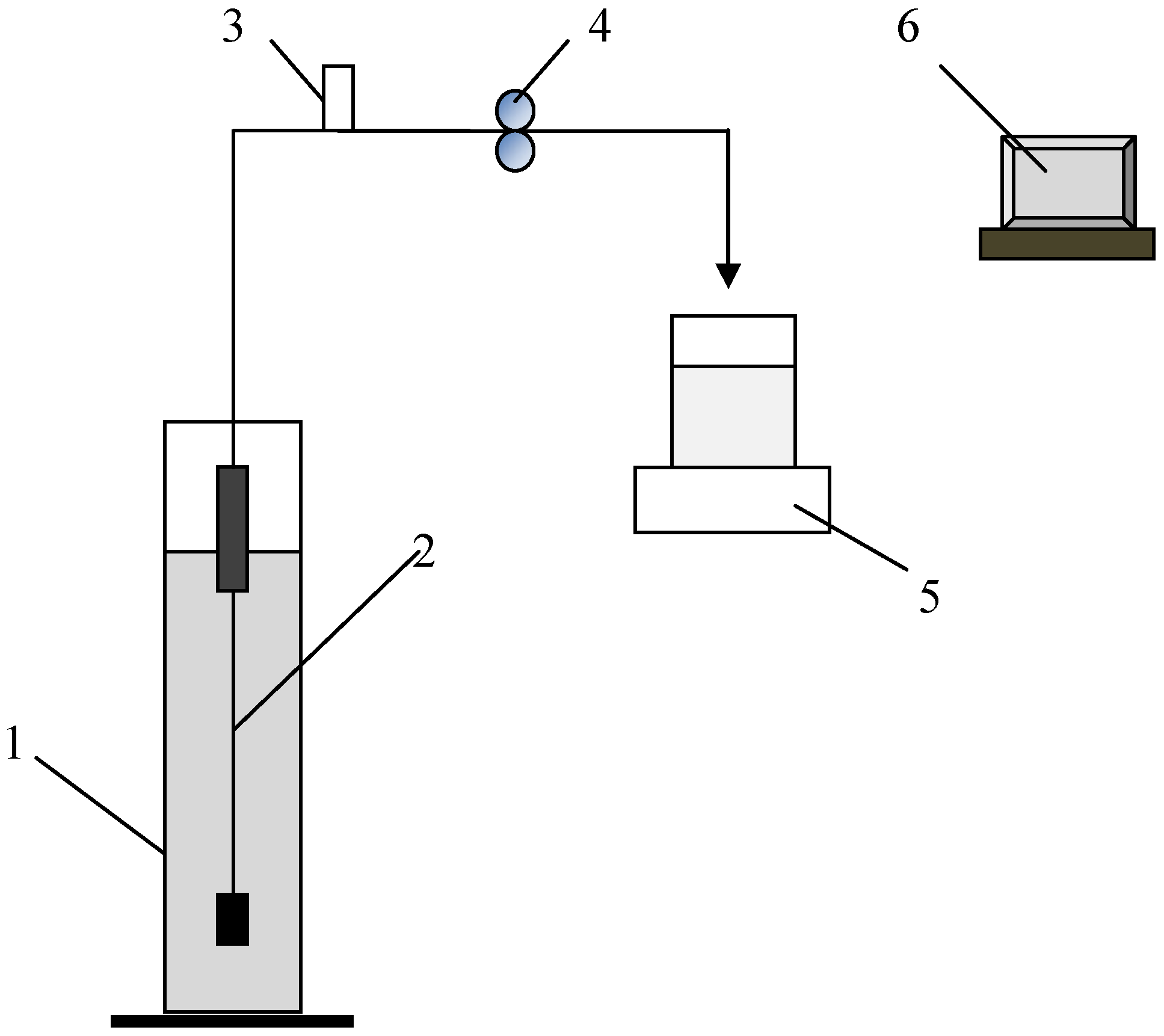
3. Results and Discussion
3.1. Zeta Potential of Alginate Molecules
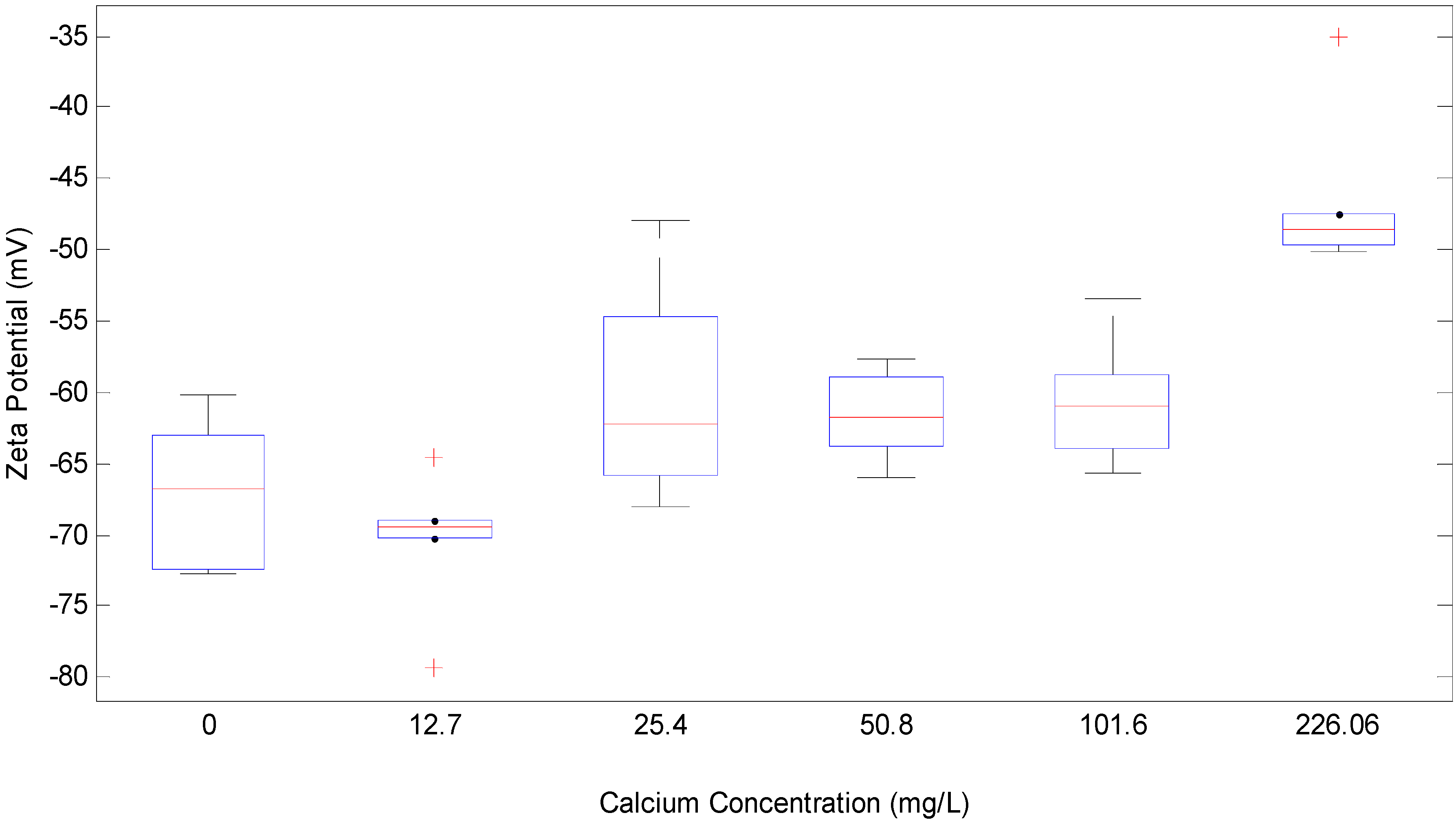
3.2. Short-Time Filtration Behavior of Alginate
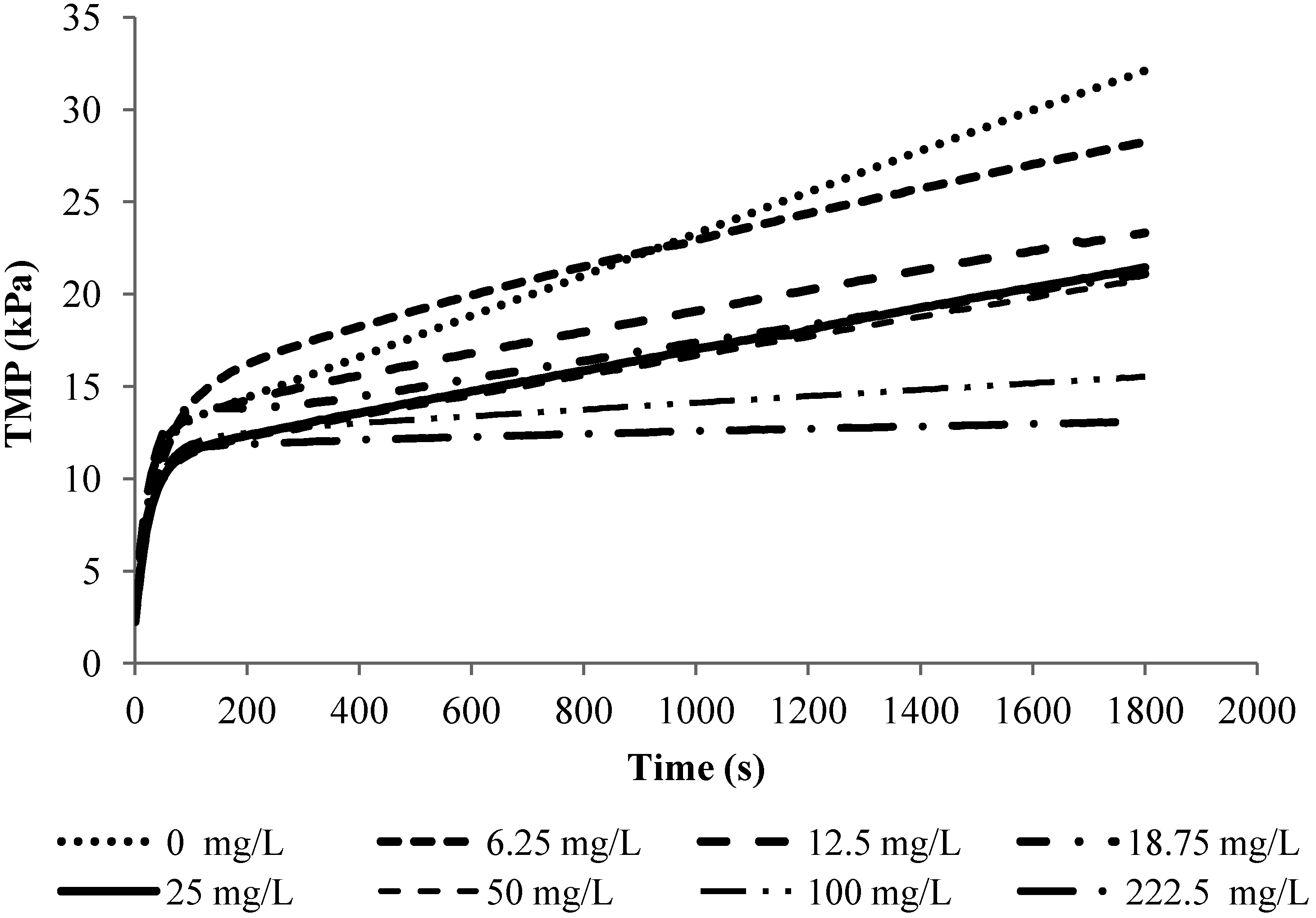
3.2.1. Factors Affecting the Linear TMP Increase Rate
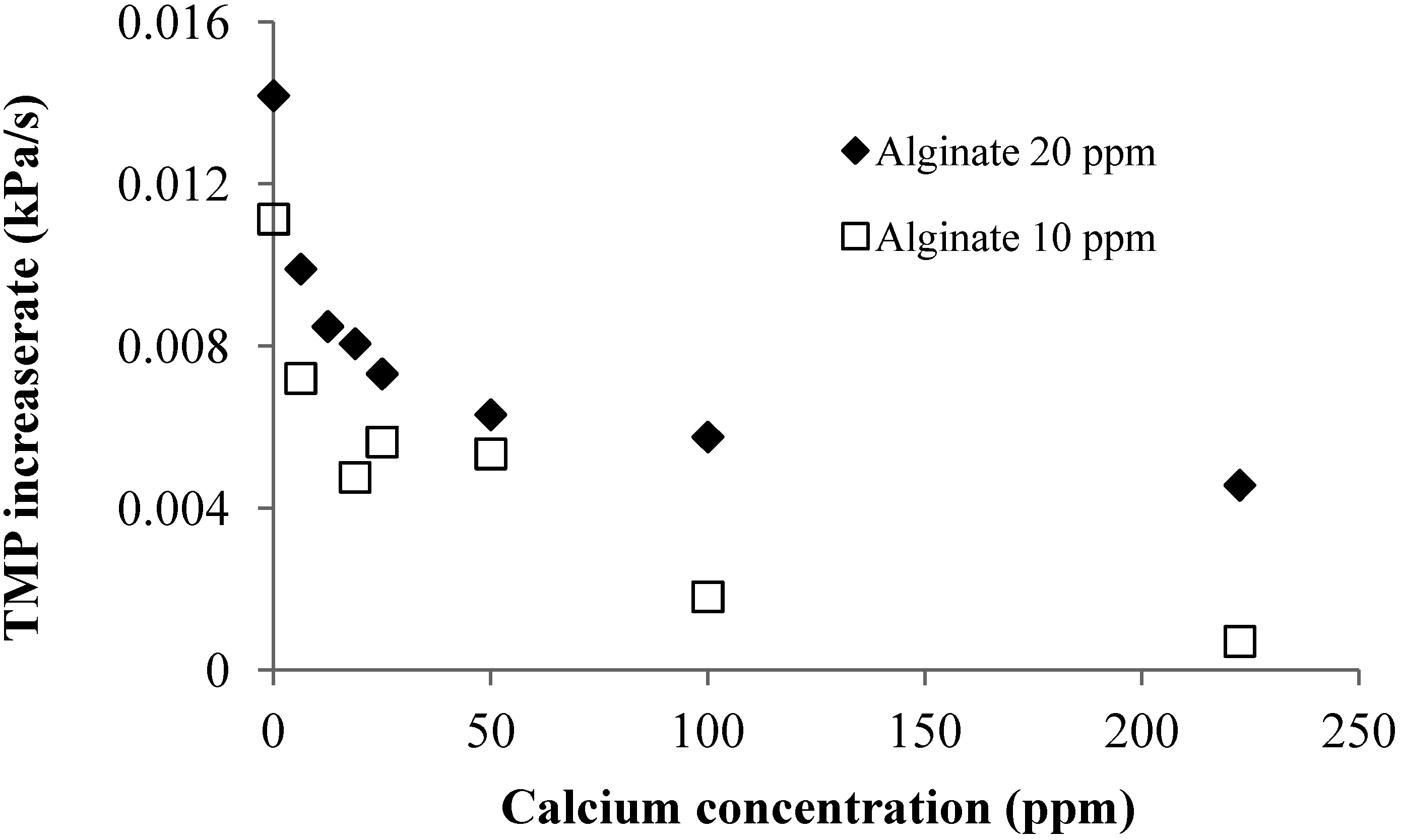



| Calcium Concentration (mg/L) | a for dTMP/dt ∝ Ja | b for αL/ϕC ∝ Jb |
|---|---|---|
| 0 | 1.70 | −0.3 |
| 6.25 | 1.80 | −0.20 |
| 18.5 | 1.97 | −0.03 |
| 100 | 2.00 | −0.00 |
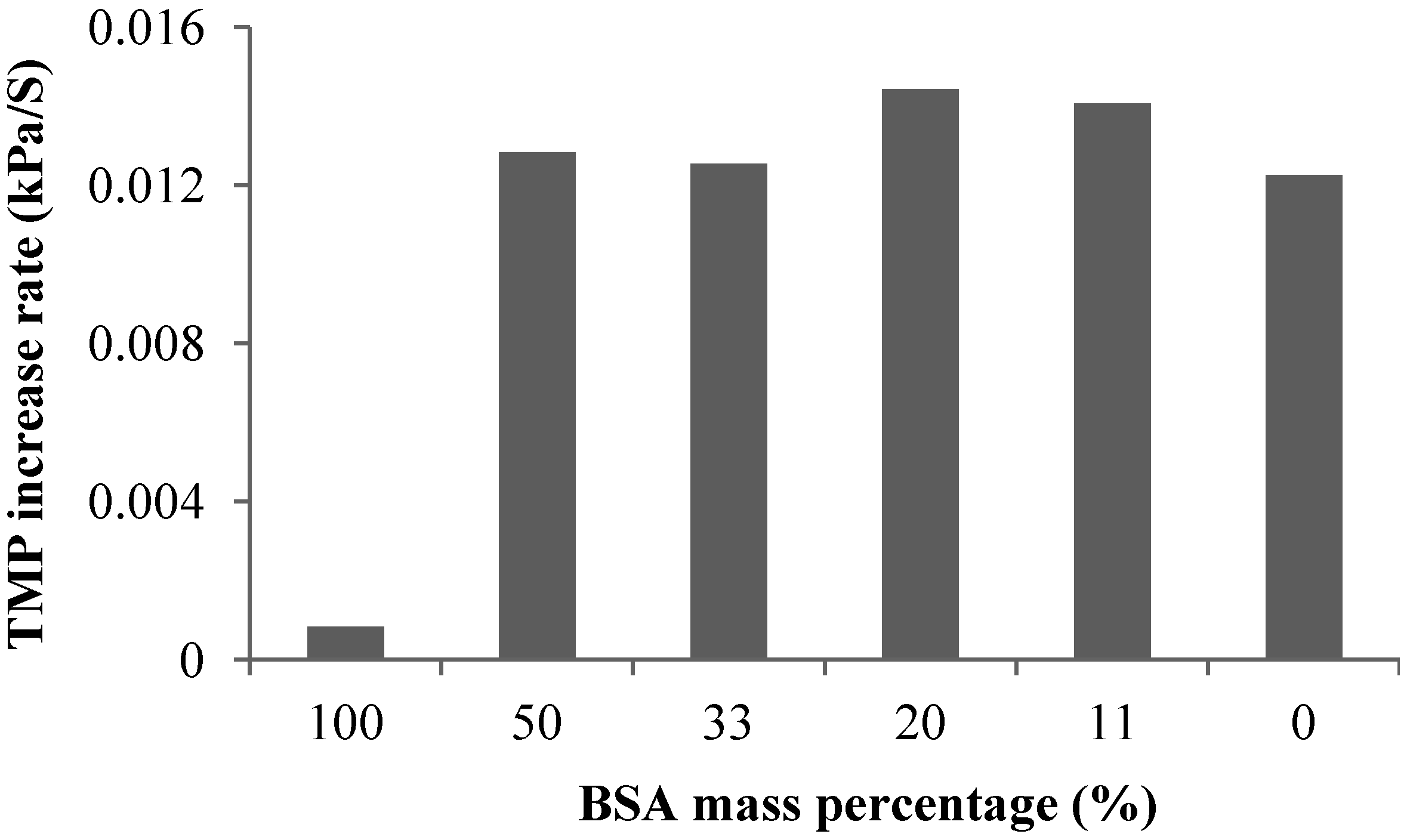
3.3. Factors Affecting Irreversible Membrane Resistance
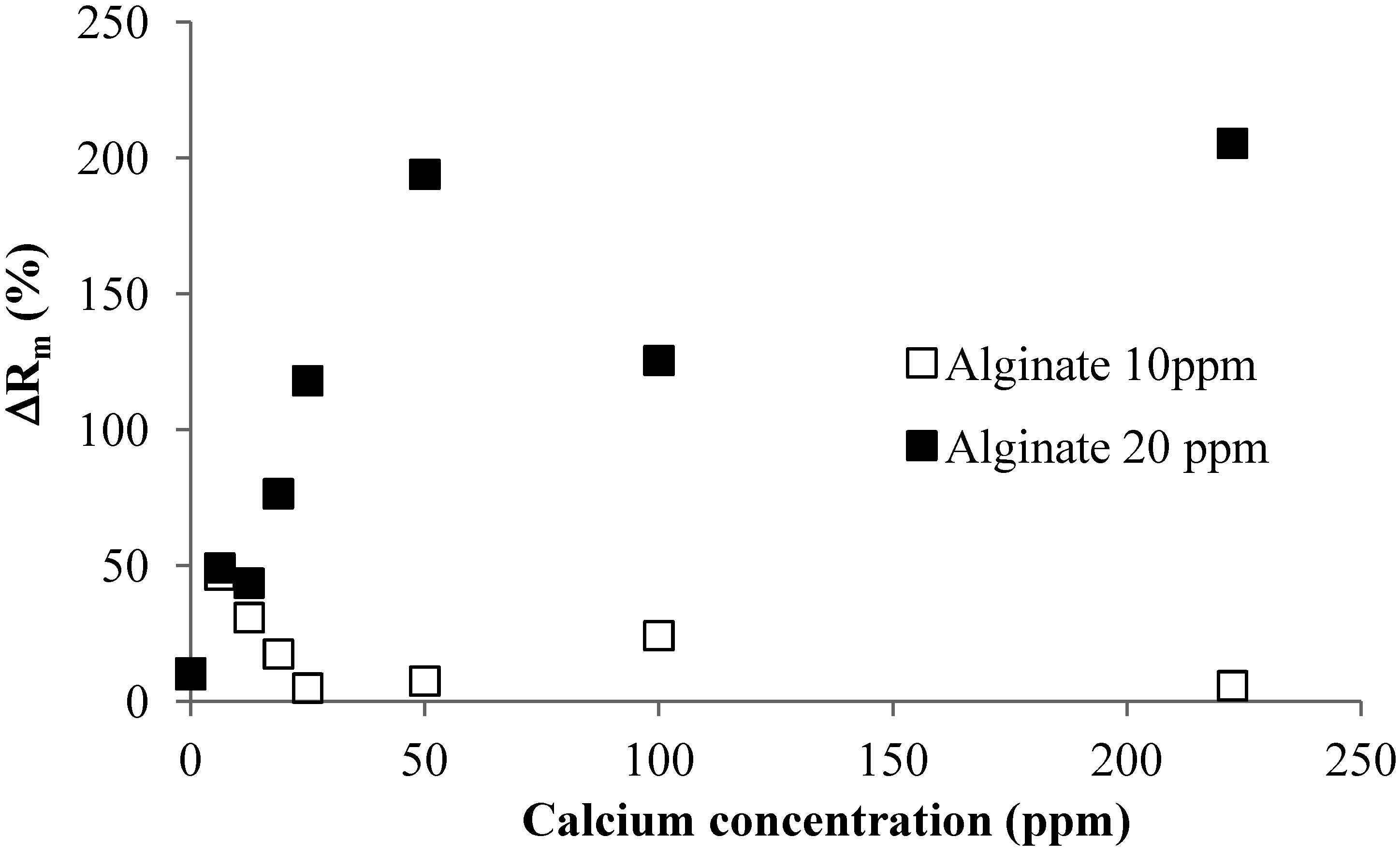


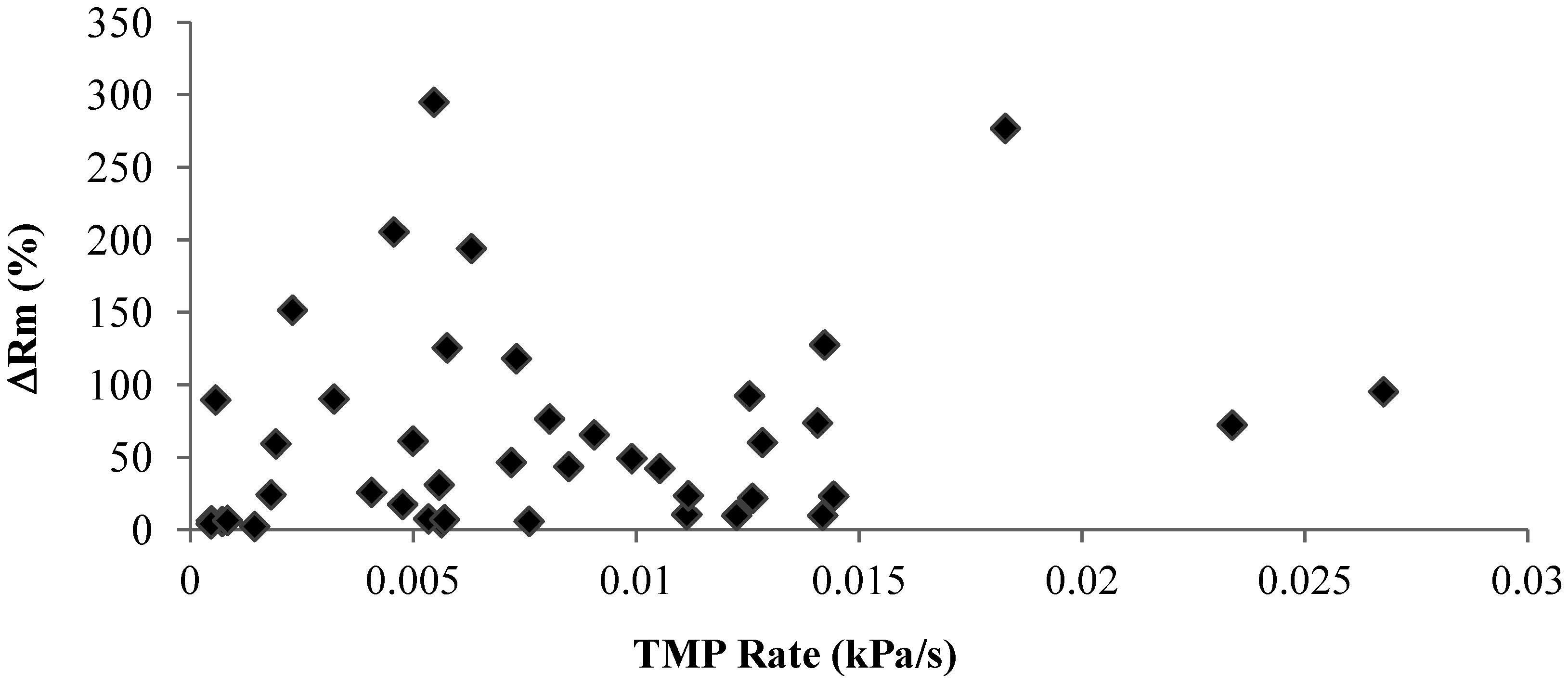
3.4. Membrane Rejection to Alginate and BSA
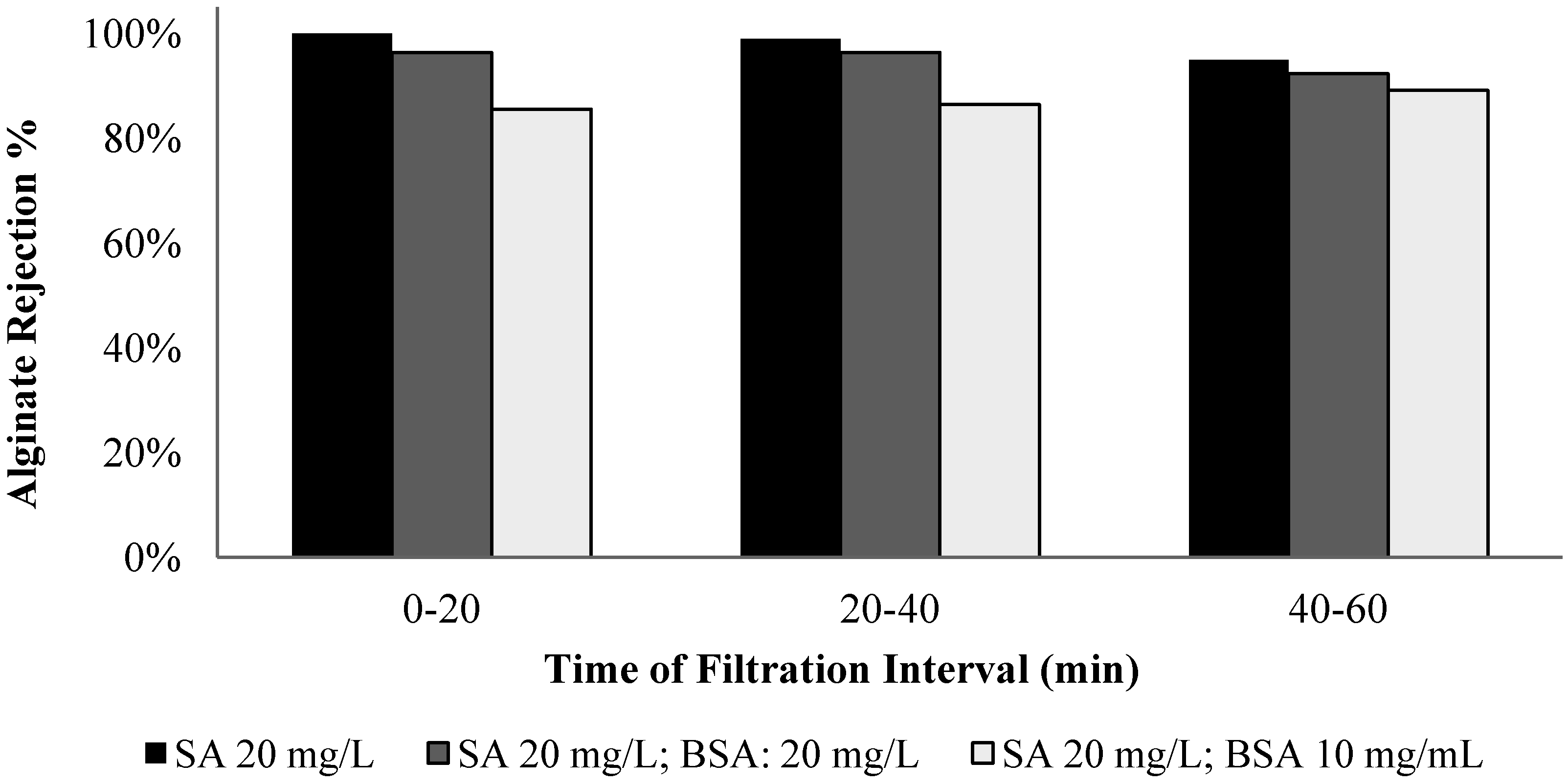
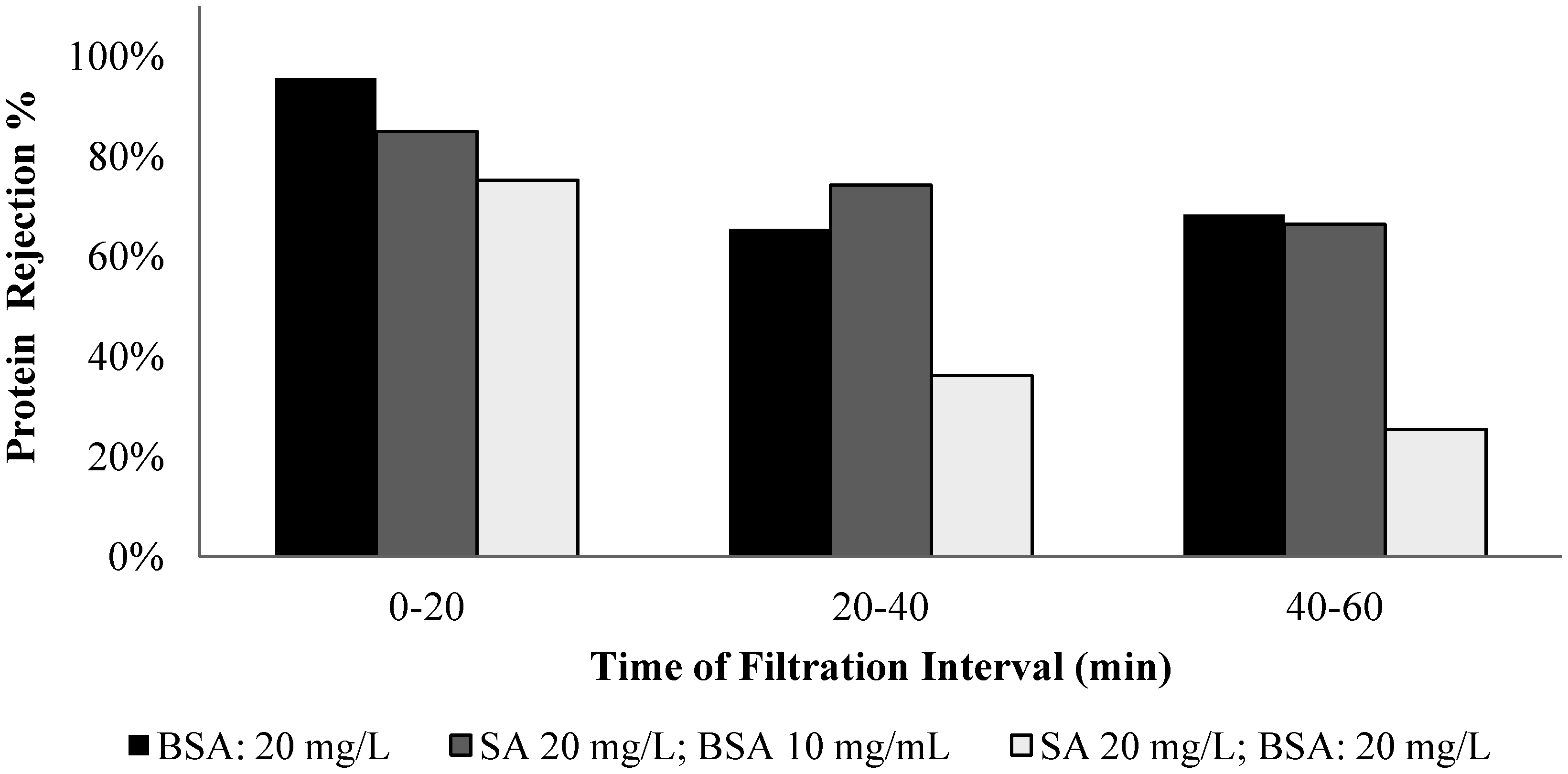
4. Conclusions
Acknowledgments
Author Contributions
Conflicts of Interest
References
- Rosenberger, S.; Laabs, C.; Lesjean, C.; Gnirss, R.; Amy, G.; Jekel, M.; Schrotter, J.C. Impact of colloidal and soluble organic material on membrane performance in membrane bioreactors for municipal wastewater treatment. Water Res. 2006, 40, 710–720. [Google Scholar]
- Lyko, S.; Al-Halbouni, D.; Wintgens, T.; Janot, A.; Hollender, J.; Dott, W.; Melin, T. Polymeric compounds in activated sludge supernatant—Characterisation and retention mechanisms at a full-scale municipal membrane bioreactor. Water Res. 2007, 41, 3894–3902. [Google Scholar]
- Shen, Y.; Zhao, W.; Xiao, K.; Huang, X. A system insight into fouling propensity of soluble microbial products in membrane bioreactors based on hydrophobic interaction and size exclusion. J. Membr. 2010, 346, 187–193. [Google Scholar]
- Kerchove, A.J.d.; Elimelech, M. Formation of polysaccharide gel layers in the presence of Ca2+ and K+ ions: Measurements and mechanisms. Biomacromolecules 2007, 8, 113–121. [Google Scholar]
- Nataraj, S.; Schomäcker, R.; Kraume, M.; Mishra, I.M.; Drews, A. Analyses of polysaccharide fouling mechanisms during crossflow membrane filtration. J. Membr. Sci. 2008, 308, 152–161. [Google Scholar]
- Wang, X.; Waite, T.D. Impact of gel layer formation on colloid retention in membrane filtration processes. J. Membr. Sci. 2008, 325, 486–494. [Google Scholar]
- Van de Ven, W.J.C.; Sant, K.V.; Punt, I.G.M.; Zwijnenburg, A.; Kemperman, A.J.B.; van der Meer, W.G.J. Hollow fiber dead-end ultrafiltration: Influence of ionic environment on filtration of alginates. J. Membr. Sci. 2008, 308, 218–229. [Google Scholar]
- Katsoufidou, K.S.; Sioutopoulos, D.C.; Yiantsios, S.G.; Karabelas, A.J. UF membrane fouling by mixtures of humic acids and sodium alginate: Fouling mechanisms and reversibility. Desalination 2010, 264, 220–227. [Google Scholar]
- Listiarini, K.; Tan, L.; Sun, D.D.; Leckie, J.O. Systematic study on calcium–alginate interaction in a hybrid coagulation-nanofiltration system. J. Membr. Sci. 2011, 370, 109–115. [Google Scholar]
- Mo, Y.; Xiao, K.; Shen, Y.; Huang, X. A new perspective on the effect of complexation between calcium and alginate on fouling during nanofiltration. Sep. Purif. Technol. 2011, 82, 121–127. [Google Scholar]
- Van de Brink, P.; Zwijnenburg, A.; Smith, G.; Temmink, H.; van Loosdrecht, M. Effect of free calcium concentration and ionic strength on alginate fouling in cross-flow membrane filtration. J. Membr. Sci. 2009, 345, 207–216. [Google Scholar]
- Listiarini, K.; Chun, W.; Sun, D.D.; Leckie, J.O. Fouling mechanism and resistance analyses of systems containing sodium alginate, calcium, alum and their combination in dead-end fouling of nanofiltration membranes. J. Membr. Sci. 2009, 344, 244–251. [Google Scholar]
- Katsoufidou, K.S.; Yiantsios, S.G.; Karabelas, A.J. Experimental study of ultrafiltration membrane fouling by sodium alginate and flux recovery by backwashing. J. Membr. Sci. 2007, 300, 137–146. [Google Scholar]
- Le Clech, P.; Jefferson, B.; Chang, I.S.; Judd, S.J. Critical flux determination by the flux step method in a submerged membrane bioreactor. J. Membr. Sci. 2003, 227, 81–93. [Google Scholar]
- Li, J.; Zhang, X.; Cheng, F.; Liu, Y. New insights into membrane fouling in submerged MBR under sub-critical flux condition. Bioresour. Technol. 2013, 137, 404–408. [Google Scholar]
- Dubois, M.; Gilles, K.A.; Hamilton, J.K.; Rebers, P.A.; Smith, F. Colorimetric method for determination of sugars and related substances. Anal. Chem. 1956, 28, 350–356. [Google Scholar]
- Bradford, M.M. A rapid and sensitive method for the quantisation of microgram quantities of protein utilizing the principle of protein-dye binding. Anal. Biochem. 1976, 72, 248–254. [Google Scholar]
- Draget, K.O.; Smidsrød, O.; Skjåk-Bræk, G. Alginates from Algae. In Polysaccharides and Polyamides in the Food Industry. Properties, Production, and Patents; Steinbüchel, A., Rhee, S.K., Eds.; WILEY-VCH: Weinheim, Germany, 2005. [Google Scholar]
- Grant, G.T.; Morris, E.R.; Rees, D.A.; Smith, P.J.C.; Thom, D. Biological interactions between polysaccharides and divalent cations: The egg-box model. FEBS Lett. 1973, 32, 195–198. [Google Scholar]
- Koseoglu, H.; Yigit, N.O.; Iversen, V.; Drews, A.; Kitis, M.; Lesjean, B.; Kraume, M. Effects of several different flux enhancing chemicals on filterability and fouling reduction of membrane bioreactor (MBR) mixed liquors. J. Membr. Sci. 2008, 320, 57–64. [Google Scholar]
- Chang, Jamal, S.; Chen, H.; Zhou, H.; Hong, Y.; Adams, N. A novel approach to analyzing concentration polarization of polysaccharide solutions. Water Sci. Technol. 2013. [Google Scholar] [CrossRef]
- Jamal, S. Filtration Behavior and Fouling Mechanisms of Polysaccharides. M.Sc. Thesis, The University of Guelph, Guelph, ON, Canada, 2014. [Google Scholar]
- Masuelli, M.A.; Illanes, C. Review of the characterization of sodium alginate by intrinsic viscosity measurements. Comparative analysis between conventional and single point methods. Int. J. BioMater. Sci. Eng. 2014, 1, 1–11. [Google Scholar]
© 2014 by the authors; licensee MDPI, Basel, Switzerland. This article is an open access article distributed under the terms and conditions of the Creative Commons Attribution license (http://creativecommons.org/licenses/by/3.0/).
Share and Cite
Jamal, S.; Chang, S.; Zhou, H. Filtration Behaviour and Fouling Mechanisms of Polysaccharides. Membranes 2014, 4, 319-332. https://doi.org/10.3390/membranes4030319
Jamal S, Chang S, Zhou H. Filtration Behaviour and Fouling Mechanisms of Polysaccharides. Membranes. 2014; 4(3):319-332. https://doi.org/10.3390/membranes4030319
Chicago/Turabian StyleJamal, Sondus, Sheng Chang, and Hongde Zhou. 2014. "Filtration Behaviour and Fouling Mechanisms of Polysaccharides" Membranes 4, no. 3: 319-332. https://doi.org/10.3390/membranes4030319





